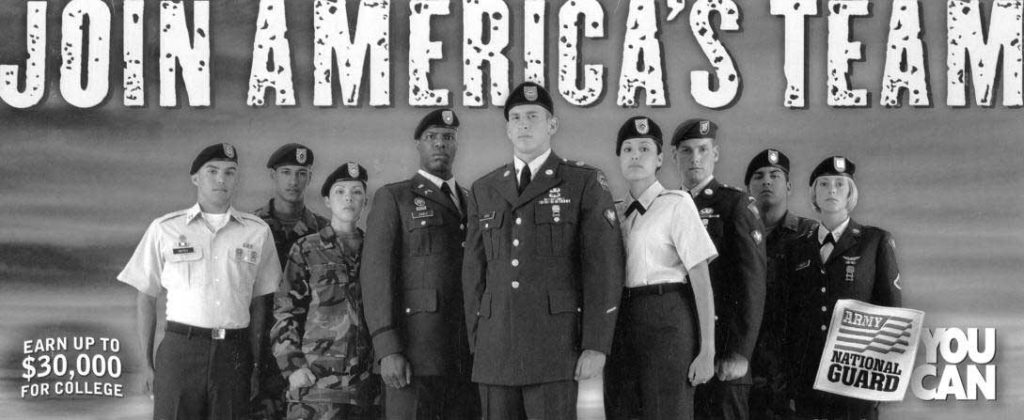Promises, Promises
What students need to know to make good decisions about military service
Over the past year I’ve spent time with high school students, and I’ve been dis-turbed by the number of them who believe the promises of military recruiters. According to the Govern-ment Accountability Office (GAO), the military spends more than $3 billion a year on slick ads and polished recruiters who tell students that the military is their best option for obtaining jobs with benefits and money for college.
As the war in Iraq continues and recruitment lags, high schools have become important military recruiting grounds. The No Child Left Behind (NCLB) act requires that public secondary schools provide the military access to students. To maximize this new access, the military has added recruiters to target students with fabulous promis-es to convince young people to enlist. Students are faced with one of the most important decisions in their lives—what to do after high school. Parents, counselors, and teachers play key roles as advisors and confidants. It is vital that students receive fuller information regarding military service and alternatives open to them. Good choices require more informa-tion. What should be included in this information?

- Promises do not need to be fulfilled. Recruiters promise cash bonus-es, good salaries and benefits, job training, and money for college. Some recruiters go further, promising enlistees excitement and travel, choice of jobs and locations, and anything else to convince someone to sign up. There are cases where recruiters promise enlistees that they will not have to go to Iraq. “Recruiters lie about college benefits, duty station assignments, veterans’ benefits, and countless other aspects of the military in order to convince their clients to sign,” said a former Marine recruiter in an article at www. objectors.org.
Students need to understand that the promises, whether well-intended or lies, do not have to be met. The Enlistment/Reenlistment Contract is a four-page document that students and pa-ents need to read carefully (http://rethinkingschools.org/wp-content/uploads/2020/07/military_enlistment.pdf). The front of the document lists all the promises, but the finer print says: “Laws and regulations that govern military personnel may change without notice to me. Such changes may affect my status, pay, allowances, benefits, and responsibilities as a member of the Armed Forces REGARDLESS of the provisions of this enlistment/reenlistment document” (DD Form 4/1, 1998, Section 9b). This means that the military can legally renege on its promises and do whatever it wants with an enlistee. - The promises of cash bonuses. All branches of the military have increased the sizes of cash bonuses. The size of the cash bonus varies depending on branch of the armed forces and job placement. Still the bonuses can seem very large to many potential enlistees. It is important to keep in mind that taxes will be taken out of these bonuses. Of tees excitement and travel, choice of jobs and locations, and anything else to convince someone to sign up. There are cases where recruiters promise enlistees that they will not have to go to Iraq. “Recruiters lie about college benefits, duty station assignments, veterans’ benefits, and countless other aspects of the military in order to convince their clients to sign,” said a former Marine recruiter in an article at www. objectors.org.
The Enlistment/Reenlistment Contract is a four-page document that students and pa-ents need to read carefully (http://rethinkingschools.org/wp-content/uploads/2020/07/military_enlistment.pdf).The front of the document lists all the promises, but the finer print says: “Laws and regulations that govern military personnel may change without notice to me. Such changes may affect my status, pay, allowances, benefits, and responsibilities as a member of the Armed Forces REGARDLESS of the provisions of this enlistment/reenlistment document” (DD Form 4/1, 1998, Section 9b). This means that the military can legally renege on its promises and do whatever it wants with an enlistee. - The promises that good jobs and job training will make the transition to civilian life easier. It is crucial to remember the words of Vice President Dick Cheney: “The reason to have a military is to fight and win wars. The military is not a social welfare agency. It is not a jobs program.” While there appears to be some crossover between military and civilian jobs—like nursing, mechanics, and electronics— military training is specialized and the skills do not translate easily into many civilian jobs. Beyond this, some of the occupational specialties have been out- sourced to private contractors in recent years, which means that these jobs are difficult for service members to obtain. Research exposes these false promises. According to an article in The Quarterly Review of Economics and Finance, veterans averaged only 1.78 months of training in 31 months of active duty. Stephen Barley, a labor policy specialist, found that the average recent veteran will earn between 11 per- cent and 19 percent less than non-veterans from comparable socioeconomic backgrounds. The Department of Labor estimates that the current unemployment rate for young veterans (ages 20-24) is more than 15 percent, nearly twice the national rate for this age group. The Bureau of Labor Statistics (2002) reported that some veterans experienced higher rates of unemployment than the general population: white males, 9.4 percent; African-American males, 17 percent; Latinas, 21.6 percent; and African-American females, 24 per- cent. And, according to Veteran Affairs and the Urban Institute, veterans make up 23 percent (33 percent of males) of the homeless population. This means that 200,000 to 300,000 veterans are homeless on any given night.
Limited training, reduced post-service earnings, higher unemployment, and possible homelessness support Barley’s conclusion that “all else being equal, young people should look to sources of training other than the military if they wish to optimize their careers.” Instead, students need to learn about alternatives that provide real job training. There are many options for students, including apprenticeship programs (in California, www.calapprenticeship.org), Job Corps (www.jobscorps.doleta.org), and Regional Opportunity Programs (www.ropcenter.org). There are thousands of opportunities to enter the workforce, be paid a salary, and receive training. - The promise of money for college. The TV ads promise $30,000, $50,000, or $70,000 for college. Recruiters lure students into enlisting with the same promises. Seldom are the restrictions explained. Sometimes this amount includes the enlistee’s pay for four to six years of service. It may include repayment of existing loans. Only a few enlistees qualify for the largest amounts, but all must “invest” $100 per month for 12 months and be granted an honorable discharge (which disqualifies about 20 percent of veterans). To receive the promised bonanza, enlistees must be placed in specialized positions and serve in high-risk combat zones. With these and other stipulations, the average payout to enlistees is much smaller than promised. In fact, according to an article in America’s Military Today, only 35 percent of veterans receive GI Bill funds and only 15 percent ever receive a college degree. Even if a veteran qualifies, there is no guarantee that funds will be available; the Bush administration continues to cut veterans’ benefits, according to Veterans for Peace.
Even though money for college is scarce, students need to learn that there are non-military alternatives to help pay for college. Each state has its own student grant and loan programs. There are federal grants (e.g., Pell Grants) and loans (e.g., Perkins and Stafford Loans). There are work-study programs. Most colleges have institutional financial aid. And there are thousands of scholarships, grants, and bursaries available throughout the country. While only 35 percent of veterans receive funding, 70 percent of applicants receive civilian financial aid, according to the Support Network for an Armed Forces Union. - The promise that the enlistee’s commitment is only four years. Students need to be aware that first-time enlistees must serve a total of eight years—four years active duty and four years reserve duty. More troubling, most recruiters do not disclose that an individual’s active duty can be extended without notice. President Bush authorized various “stop-loss” measures, and individuals who served their full eight years have been given new discharge dates as far into the future as December 24, 2031. There is no guaranteed “exit” date for enlistees.
The military’s need for new enlistees is urgent. While some of the recruitment budget has been spent on increasing the military’s profile in our communities through the media, the major thrust has been to increase the number of military recruiters. While media advertising may pique interest, the “selling” of the military is still entrusted to thousands of military recruiters who build on the ads to portray enlistment as a desirable choice for the future. They downplay the danger and possibilities of injury or death. Instead, recruiters entice enlistees with promises of money for college and job training. Some recruiters may make promises in good faith, but as is well documented, others simply lie. Military recruiters can say anything and promise anything because they are not held accountable for their promises. Once someone has signed an enlistment contract and reported for duty, there is little recourse. Students need to understand that the Enlistment Contract is not a regular employment contract. If they enlist, they cannot quit.
Enlistees give up their constitutional rights and live under different rules and laws. The military can change enlistees’ jobs, pay, or benefits without notice.
More military recruiters have been dispatched to high schools, shopping malls, community events, and wherever young people gather. This full-court press is one-sided. Every person deserves the opportunity to make a well-informed decision about military enlistment. Once the myths have been exposed and missing information given, students can make better decisions about their futures.

